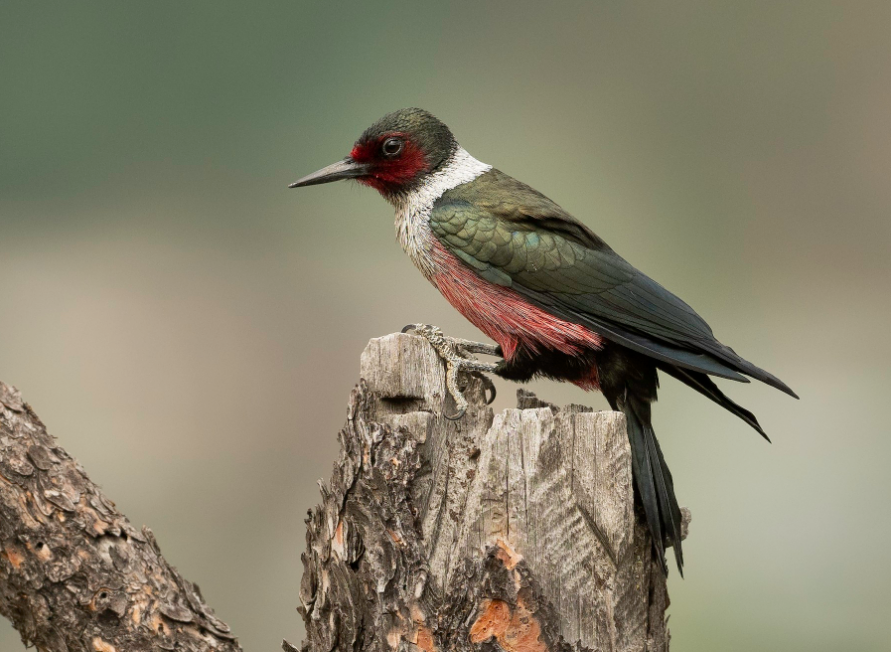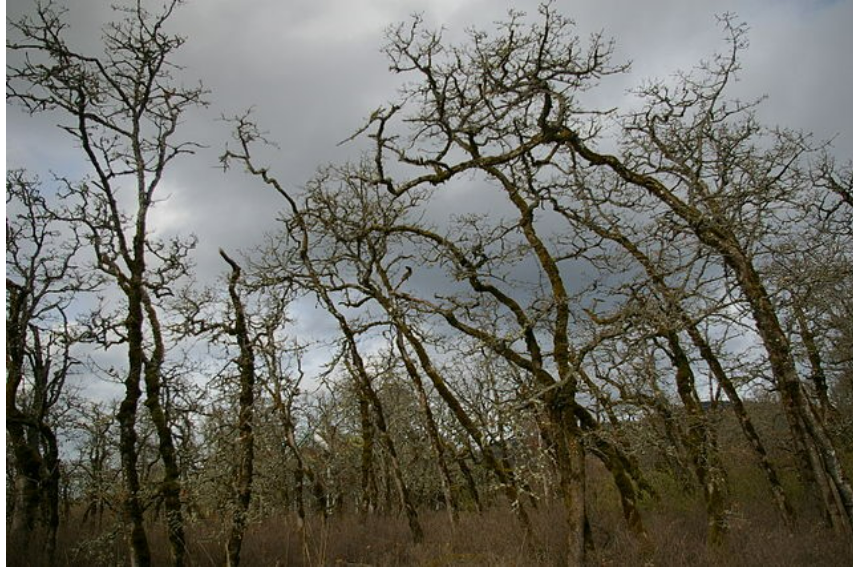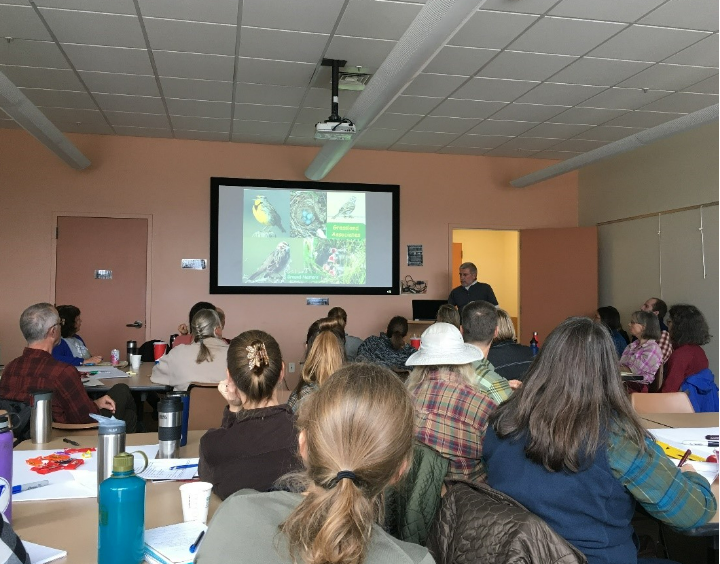Columbia Land Trust’s East Cascades Oak Partnership

East Cascades Oak Partnership
Why Bird Conservation?
The Eastern Cascades region in the Northwestern United States is cherished by human and avian inhabitants alike, forging deep connections between people and the outdoors — and creating valuable opportunities for stakeholder-informed conservation.
This area is home to an ecologically diverse community of oak woodlands and is the location of many Columbia Land Trust (CLT) conservation projects in Oregon and Washington. At the foot of the Cascades, wet transitions to dry over a short distance. This steep moisture gradient combined with extreme topography, and the influence of the Columbia River Gorge, creates unique niches for a wide variety of flora and fauna. These diverse ecological characteristics of the Eastern Cascades also provide important habitat for many species of birds.
In order to preserve a connected and intact oak woodland ecosystem in the Eastern Cascades, CLT recognized the need to bring together a diverse array of partners. CLT, along with other partners, formed the East Cascades Oak Partnership (ECOP), a collaborative that shifts oak conservation strategies from single properties to entire landscapes and natural systems, as well as emphasizes partnerships as key to conserving more land for the benefit of both people and birds.
There is a mutualistic relationship between many birds and oak woodlands. Just as intact oak landscapes provide habitat for birds, the presence of birds is also critical for oak landscapes. The Oregon White Oak, for instance, relies on birds for the distribution of its acorns, a reciprocal relationship that is crucial for the survival of this tree species. Lindsay Cornelius, CLT Natural Area Manager, says that birds are integral to the connections that people form with the land. “Birds are literally one of the most colorful aspects of life in the East Cascades,” Cornelius noted. “Apart from playing critical roles in the ecology of oak woodlands, they delight the senses with song and movement and color. Who among us could see a Western Tanager or hear a Meadowlark song and not be moved?”

The conservation of oak woodlands in the Eastern Cascades is also increasingly important for birds in the face of climate change. A 2015 study conducted by the Nature Conservancy found that the East Cascades will be one of the most climate change-resilient ecological regions in the Pacific Northwest, but also contains a comparatively low amount of protected lands. This results in a large opportunity for conservation in the region. The resilience of the oak forests in this area is imperative for already threatened bird species in the region, such as Lewis’s Woodpecker, whose range of habitat will be constrained by the impacts of climate change.
Spotlight Resources: Collaborative Partnerships and Mapping
With funding from the Cornell Lab’s Land Trust Small Grant Program, CLT is fostering collaborative, landscape-scale conservation of white oak systems through ECOP. CLT works to create effective partnerships between public, private, tribal, and nonprofit organizations to protect and restore oak habitats in the East Cascades Region. These partnerships allow CLT to assess existing conservation projects, as well as threats and opportunities for conservation and related knowledge gaps.
Resulting efforts of ECOP included a tour and discussion around an often divisive practice in oak woodlands: grazing. The practice was identified as a challenge by Partners in Flight’s “Conservation of Landbirds and Associated Habitats and Ecosystems in the East Cascade Mountains of Oregon and Washington” and members of ECOP. CLT, in conjunction with the Natural Resource Conservation Service (NRCS) and the Xerces Society for Invertebrate Conservation, held a full day event around learning about the benefits of grazing as a landscape management tool. As discussed at the educational event, grazing can be used to maintain habitats that support pollinators and invertebrates, which are sources of food for birds, and specific bird species themselves. The event brought together ranchers and environmentalists — two groups often regarded as having opposing viewpoints — for a meaningful and productive dialogue about balancing oak conservation, biodiversity preservation, and the livelihoods of ranchers.

CLT also utilized mapping to prioritize geographic areas in the Eastern Cascades for certain conservation strategies determined by ECOP. One source of information for these maps is data from eBird, a free online bird monitoring program, used to determine the presence of oak-dependent bird species in the Northwest. By mapping eBird data and the presence of oak species, CLT can better understand the distribution of oak woodlands and where to target conservation efforts to protect the biodiversity of the entire region.
Advice for Other Land Trusts
As a collaborative group that encompasses over 125 people, ECOP has its challenges in reconciling differing levels of engagement and knowledge amongst its stakeholders. However, CLT found that the use of committees and presentations at meetings were helpful tools. Committees allowed large, complex planning elements to be organized into more manageable discrete tasks. By including four to five presentations during each formal meeting, CLT not only increased meeting attendance and engagement, but also facilitated new connections and learning amongst a variety of stakeholders. Each of these presentations was focused on a specific topic, including a presentation on birds to ensure that all of the partners had a shared understanding about bird behavior and conservation. This collective knowledge ultimately informed partners’ land management and planning decisions.
Cornelius says the learning that resulted from the collaborative nature of ECOP and these presentations created an environment conducive to sharing and made it easier for partners to consider a multitude of perspectives about the management and conservation of the Eastern Cascades. “We are hearing from First Nations, ranchers, real estate brokers, recreationists, foresters, first responders, prescribed fire practitioners, developers, vintners and orchardists,” Cornelius explains. “Understanding the human behaviors in oak systems that impact the extent and quality of oak habitats is critical to developing strategies that improve outcomes for oak systems and for the organisms who rely on them — including people.”
Next Steps
Since receiving Land Trust Small Grant Program funding, CLT has continued to work with ECOP to protect the oak woodlands and birds of the Eastern Cascades Region. More recently, ECOP has completed its 2020-2030 Strategic Plan for collaborative partner-driven oak conservation. The Strategic Action Plan is informed by a plethora of scientific research, local stakeholder knowledge, traditional ecological knowledge, and a commitment to adaptation. The current and future efforts of ECOP continue to be fueled by the urgency of the loss of biodiversity in the region, including the loss of many songbirds.
“We have a responsibility to ourselves, our neighbors, and future generations to steward resources responsibly,” Cornelius says. “And that includes securing and managing healthy spaces for our feathered friends.”


